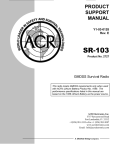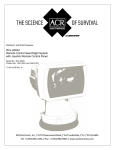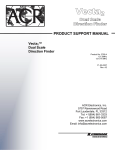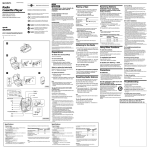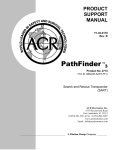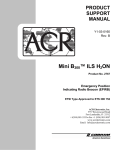Download ACR Electronics SR-103 Specifications
Transcript
About Cobham Life Support, ACR Products Cobham Life Support, ACR Products, www.acrelectronics.com, designs and manufactures a complete line of safety and survival products including EPIRBs, PLBs, AIS, SARTs, Strobe Lights, Life Jacket Lights, Search Lights and safety accessories. The quality systems of this facility have been registered by UL to the ISO 9001:2000 Series Standards. Recognized as the world leader in safety and survival technologies, ACR has provided safety equipment to the aviation and marine industries as well as to the military since 1956. About Cobham plc Cobham plc is an international company engaged in the development, delivery and support of advanced aerospace and defence systems for land, sea, air and space, The company has four divisions that collectively specialize in the provision of components, subsystems and services that keep people safe, improve communications and enhance the capability of aerospace and defence platforms. CAUTION: Before proceeding to install, test or use your new ACR Electronics’ product, please read this Product Support Manual in its entirety. If you have questions regarding the contents of the manual, please contact our Technical Service Department at ACR Electronics, Inc., Telephone +1 (954) 981- 3333. Please be ready to provide the technician with the page number you wish to discuss. If you have a question that is not covered in the manual, please visit our website and access the Frequently Asked Questions (FAQs) section for further information or call our Technical Service Department. The website address is www.acrelectronics.com. If in the future you lose this manual, you may access and print a replacement on the ACR website. Call Sign: ______________________________________ Vessel: ________________________________________ Battery Expiration Date: ___________________________ Table of Contents SECTION 1 – INTRODUCTION ______________________________ 3 SECTION 2 – PREPARING TO INSTALL ________________________ 4 SECTION 3 – INSTALLING THE SR-103™ SURVIVAL RADIO ________ 6 SECTION 4 – OPERATING THE SR-103™ SURVIVAL RADIO ________ 6 SECTION 5- SENDING DISTRESS COMMUNICATIONS ____________ 9 SECTION 6 – MAINTAINING THE SR-103™ SURVIVAL RADIO ____ 10 APPENDIX A – OPERATING FREQUENCIES ____________________ 15 APPENDIX B – BATTERIES AND CHARGERS ___________________ 17 APPENDIX C – TECHNICAL SPECIFICATIONS ___________________ 17 APPENDIX D – WARRANTY, USEFUL LIFE POLICY, NOTICES _______ 18 PLEASE READ ALL WARNINGS, CAUTIONS AND NOTES CAREFULLY Y1-03-0128F 2 SECTION 1 – INTRODUCTION OVERVIEW This manual contains necessary information for the operation, maintenance and performance of distress communications utilizing the ACR/2727 Multichannel Survival Craft Portable Two-Way Radiotelephone. The user is strongly recommended to read this manual in its entirety. A photocopy of the suggested procedures for distress communications outlined in Section 5 should be kept with each radiotelephone to aid the designated operator and maximize the intelligibility and success of his radio distress request. The Multichannel Survival Craft Portable Two-Way VHF Radiotelephone is intended to be used for on-scene emergency communications between survival craft and ship, and survival craft and rescue units. The radio is equipped with a 5 year lithium survival battery pack which is user replaceable. With the lithium battery pack installed, the unit meets all IMO, SOLAS and FCC requirements for survival craft two-way VHF transceivers. An optional rechargeable MaxCap™ battery pack is also available. RADIO LICENSE REQUIREMENTS This radio is FCC Type Accepted and GMDSS listed (FCC Part 80.1101) as a survival craft two-way VHF radiotelephone apparatus which complies with the 1988 GMDSS SOLAS amendments. To install the radio on a survival craft, the host ship must have a valid Ship Station License as required by law. To obtain an application for an FCC Ship Station License (U.S. ships), the user should contact the nearest FCC office. In the USA, contact the Federal Communications Commission (FCC) at www.fcc.gov on the internet. You will need Form 605, “Quick-Form Application for Authorization in the Ship, Aircraft, Amateur, Restricted and Commercial Operator, and General Mobile Radio Services”, which may be downloaded or completed online. You may also call FCC’s Forms Distribution Center at 800-418-3676. Please note that regulations for VHF radios may be different in different parts of the world. Always contact your local authority to determine the requirements that apply to you. Y1-03-0128F 3 SECTION 2 – PREPARING TO INSTALL ITEMS INCLUDED IN PURCHASE: 1. Multichannel Survival Radio with lithium battery, wrist lanyard and radio cover 2. Warranty card 3. Commercial Registration Advisory 4. Product Support Manual If any of the above is missing, please contact ACR Electronics’ Technical Service by email at service@acrelectronics,com or by phone at +1 (954) 9813333. Figure 1ACR Multichannel Survival Craft Portable Two-Way Radiotelephone Y1-03-0128F 4 ANATOMY OF THE SR-103™ RADIO The key components of the SR-103™ Radio are: Figure 2SR-103™ Main Features Y1-03-0128F 5 SECTION 3 – INSTALLING THE SR-103™ SURVIVAL RADIO The Survival Radio and its protective cover shall be packed with the ship’s survival craft or in a survival suit. When not packed with a life raft, the radiotelephone should be stored in an accessible place, as close to the survival craft as possible. SECTION 4 – OPERATING THE SR-103™ SURVIVAL RADIO All radio controls (except the ON/OFF switch) are flat-panel, push-types located on the front surface of the radio. PTT: Push-To-Talk activates transmitter while switch is depressed. When switch is released, radio returns to receive mode automatically. Also refreshes channel display for 1 sec. VOL ▲: Volume ▲ increases audio output level to maximum, VOL▼: Volume ▼ decreases audio output level ON/OFF: Press for one (1) second to turn ON. Press again to turn OFF. CHAN ▲: Switches channels in increasing channel order CHAN ▼: Switches channels in decreasing channel order Figure 3- Control Panel Y1-03-0128F 6 OPERATING INDICATORS CHAN ▲ CHAN ▼ VOL ▲ ▼ PTT CHANNEL The switch includes a RED light which will be illuminated when the radio is ON and Channel ▲ is selected. The switch includes a GREEN light which will be illuminated when the radio is ON and Channel ▼ is selected. Both of these switches will light up YELLOW when the PTT switch is depressed, indicating that radio is transmitting. The switch blinks YELLOW at a slow rate to assist operator in locating the PTT switch in darkness. Indicates which channel is selected DISPLAY ACTIVATING THE UNIT 1. Locate slide switch on upper right side of unit. 2. Using thumb, push slide switch up to ON position. 3. Front panel will illuminate and noise will be heard coming from speaker. After 3 seconds, automatic squelch will mute the noise. 4. To turn unit off, push slide switch down to OFF position. SELECTING A CHANNEL CAUTION: To assure ease of operation in an emergency, the radio will be tuned to Channel 16 immediately after it has been turned on. In non-emergency situations, the user must select a new channel. Channel 16 should only be used in the event of an emergency. 1. To select the next higher channel, briefly press the CHANNEL ▲ key. 2. To select the next lower channel, briefly press the CHANNEL ▼ key. 3. To select other channels, press and hold either the CHANNEL ▼ key or the CHANNEL ▲ while observing the channel display. Release the key when the desired channel appears on the display. 4. Certain channels used internationally for duplex operation, have been designated in the United States by the FCC with an “A” suffix as simplex channels. The GMDSS Survival Radio uses simplex (single-frequency) operation only. Therefore, these channels all have an “A” suffix: Y1-03-0128F 7 01A 02A 03A 04A 05A 07A 61A 62A 63A 64A 65A 66A 78A 79A 80A 81A 82A 83A 88A 5. The channels appear on the display in the following order: VHF marine band channels 01A- 28 VHF marine band channels 60- 88A VHF marine weather channels -1 through -0, display (WX1WX10) The order is rolled over, i.e., WX10 is followed by Channel 1A. 6. The channel designators are displayed as follows: a. Simplex only channels — the channel number remains on the display for five (5) seconds after the CHANNEL ▲or CHANNEL ▼ key is released. The display is then blanked to conserve battery power. b. Simplex/duplex channels (“A” suffix) — The ACR survival radio uses simplex mode only. After the channel has been selected, the channel number followed by the “A” alternately flash one (1) second each for five (5) seconds. The display is then blanked. c. Weather channels — The display consists of a “-” followed by the single-digit channel number. For WX10, the display shows -0. The display is lighted for five (5) seconds after the channel is selected, then is blanked. 7. To restore the channel display, press PTT briefly. LEDs will show current channel number for one (1) second (simplex/duplex channels — channel numbers for ½ second followed by an “A” for ½ second). RECEIVING A CHANNEL AND SETTING VOLUME 1. The radio is in receive-mode as soon as a channel is selected. Automatic squelch circuit will cause unit to be silent unless a signal is present on the selected channel. 2. To lower the volume, press the VOLUME ▼key. Repeated pressing of the VOLUME ▼ key will step through the volume settings until lowest setting is reached. 3. To raise the volume, press VOLUME ▲key. Unit will be set to maximum volume. 4. To receive very weak signals, it may be helpful to turn off the automatic squelch. This may be done by pressing both VOLUME ▲and VOLUME ▼simultaneously. Noise will be heard from speaker when squelch is turned off. Pressing any key will restore the automatic squelch. Y1-03-0128F 8 CAUTION: Operating unit with squelch off for long periods of time will reduce battery life. TRANSMITTING 1. Select channel. 2. Press and hold PTT (Push To Talk) button. PTT, VOLUME ▲and VOLUME ▼keys will illuminate. 3. Speak loudly and clearly into speaker area from a distance of approximately 3" to 6" (7.5 to 15 cm). 4. Release PTT button to return to receive mode. BATTERY SAVE FEATURE To conserve battery life, the unit will automatically shut-off following a period of approximately 20- 30 minutes of idle radio activity. SECTION 5- SENDING DISTRESS COMMUNICATIONS The following are a set of observations intended to help the user maximize his success during the course of a rescue where two-way communication is possible. 1. Transmit only when the channel is clear of activity, or between other stations' transmissions during a distress. 2. Use the world recognized expression M'AIDER or MAYDAY to call for help. Note that MAYDAY is commonly pronounced as it is read in English, when utilized in English speaking countries. To improve the chances of being understood internationally, it is best to pronounce the above expression two ways: a. The internationally recognized way, M'AIDER (in French) pronounced phonetically as “mě - dě,” (see any French language instruction book for further details) and, b. The commonly used pronunciation in English speaking countries MAYDAY pronounced phonetically as “mā - dā.” To prevent the distress signal from being misunderstood, and to improve the intelligibility of the distress call, use the two pronunciations above when calling, for example (also, see example for part c): “M’AIDER MAYDAY M’AIDER THIS IS MARY JANE WXT599 WXT599 WXT599”. 3. Always use the ICAO Convention (Convention on International Civil Aviation) recognized alphabet for spelling. Y1-03-0128F 9 ICAO recognized alphabet: A B C D E F G H I J K L M Alpha Bravo Charlie Delta Echo Foxtrot Golf Hotel India Juliet Kilo Lima Mike N O P Q R S T U V W X Y Z November Oscar Papa Quebec Romeo Sierra Tango Uniform Victor Whiskey X-ray Yankee Zulu EXAMPLE: “M’AIDER MAYDAY M’AIDER THIS IS MARY JANE Whiskey X-ray Tango 599 Whiskey X-ray Tango 599 Whiskey X-ray Tango 599” To acknowledge that a transmission has been received and understood in its entirety, simply use the expression “R R R” spoken as “Romeo Romeo Romeo” (“R” stands for received). Note: some radio operators use the expression “Roger” instead of “Romeo”. 4. Antenna height and range of communications are intimately related. In general, a higher antenna will have a longer range than a similar lower antenna. The typical range for a transmitting radio held at about 1.2 meters (4.0 ft) above average water level is expected to equal 4.5 kilometers (2.8 statute miles). The receiving shipborne antenna can extend the range if it is mounted high. Airborne receivers greatly extend the above range (over 150 kilometers/100 miles for aircraft flying over 1500 meters/5000 ft). Because of the above fact, and to maximize the range of the survival craft VHF radiotelephone, the unit should be held as high as possible without endangering the safety of the operator. SECTION 6 – MAINTAINING THE SR-103™ SURVIVAL RADIO MANDATORY TESTING Radiotelephones operated within the U.S.A. must be operationally tested on a periodic basis (FCC regulations, Part 80, section 80.834, until superseded by section 80.1095). Y1-03-0128F 10 To test the radiotelephone, follow the steps given below. NOTE: This test requires that a separate VHF marine radio transceiver be used to monitor transmitted and received signals. Any transmissions effected for the purpose of testing the Survival Radio shall be as brief as possible. The recommended test message format is as follows: “<name of station receiving the test message> THIS IS <name of station transmitting this text><station call sign or call letters>”. EXAMPLE: “BLUE DUCK THIS IS MARY JANE WXT599”. When a second radiotelephone or the ship's receiver is utilized to monitor proper operation of the Survival Radio, the test distance between devices should be kept to a maximum and the following message format should be observed: “<name of station transmitting this text> THIS IS <name of station transmitting this text> MOBILE 1”. EXAMPLE: “MARY JANE THIS IS MARY JANE MOBILE 1 WXT599” NOTE: If the unit to be tested is not on board the vessel containing the fixed station, “UNIT 1” should be used rather than “MOBILE 1”. 1. Remove the radio from its survival craft package. 2. Remove control panel protective cover. 3. Slide ON/OFF switch up to ON Figure 4- Protective Cover position. 4. Listen for the tone and for the squelch action 3 seconds after activating the unit. 5. The receiver tunes to Channel 16 automatically when unit is turned ON. 6. Listen for any activity on the frequency (channel 16). 7. If no activity is detected, transmit the test message and have someone monitor the transmission (see above for suggested test message formats). Y1-03-0128F 11 8. If the test signal was not heard (full quieting), replace the battery and retest. If the test signal is still not heard (full quieting), have the unit inspected at your nearest authorized service center. 9. Have someone return the call from the monitoring station (lowest power setting) to verify proper radiotelephone receiver operation. 10. If a response is not heard (full quieting), have the radio unit inspected at your nearest authorized service center. 11. Press the CHAN ▼ key to tune unit to any channel (except Channel 16). 12. Set the monitoring transceiver to the same frequency (see Appendix for operating frequencies). 13. Listen for any activity. 14. If no activity is detected, transmit the test message and have someone monitor the transmission (see above for suggested test message formats). 15. If the test signal was not heard (full quieting), have the unit inspected at your nearest authorized service center. 16. Have someone return the call from the monitoring station (lowest power setting) to verify proper radiotelephone receiver operation. 17. If a response is not heard (full quieting), have the radio unit inspected at your nearest authorized service center. 18. Slide ON/OFF button to turn unit OFF. 19. Replace control panel protective cover. 20. Replace unit into its survival craft package. VISUAL INSPECTION Periodically inspect the Survival Radio for damage, cracks and front panel label wear. Wipe off any salt deposits with a damp cloth. Y1-03-0128F 12 BATTERY INFORMATION Figure 5- Battery Installation Battery options Lithium Survival Battery (Product No. 1066) The Survival Radio is supplied with a replaceable lithium battery pack. This primary battery pack will operate the radio for at least 8 hours, in compliance with IMO/SOLAS and FCC requirements for a survival craft radio. To maintain compliance with these regulations, the lithium battery pack must be replaced after 5 years or after any use (with the exception of activating the unit for the purpose of testing.) Additional lithium battery packs may be stored in survival craft along with the radio for extended operating life. CAUTION: The battery is internally fused to avoid fire hazard. Do not immerse in water, short circuit or incinerate. Y1-03-0128F 13 MaxCap™ Rechargeable (Ni-Cad) Battery (Product No. 1067) To allow the survival radio to be used in non-emergency situations, a rechargeable battery pack (ACR Product No. 1067), and a MaxCap™ Charger (ACR Product No. 2711) are also available. The rechargeable battery pack will operate the unit for approximately four to six hours. The charger is capable of charging the battery in less than 135 minutes. Refer to charger manual for charging instructions. CAUTION: When the radio is operating with the rechargeable battery pack, it does not comply with the SOLAS/GMDSS regulation for battery life. How to replace the battery pack Lift the battery handle, turn it counter-clockwise until it stops and pull the battery out. Replace a fresh battery into the rear of the radio. Turn the handle clockwise until it stops and snap it down to lock into position. Make sure battery is engaged by turning the unit ON and then OFF. Y1-03-0128F 14 APPENDIX A – OPERATING FREQUENCIES CHANNEL DESCRIPTION TRANSMIT (MHz) MODE RECEIVE (MHz) 01A Port Operations 156.050 S 156.050 02A Port Operations 156.100 S 156.100 03A Port Operations 156.150 S 156.150 04A Port Operations 156.200 S 156.200 05A Port Operations 156.250 S 156.250 06 Intership Safety 156.300 S 156.300 07A Commercial, Intership 156.350 S 156.350 08 Commercial, Intership 156.400 S 156.400 09 Com’l/Non-Commercial 156.450 S 156.450 10 Commercial, Intership 156.500 S 156.500 11 Commercial, Intership 156.550 S 156.550 12 Port Operations 156.600 S 156.600 13 Bridge to Bridge 156.650 S 156.650 14 Port Operations 156.700 S 156.700 15 Environmental 156.750 S 156.750 16 Distress, Safety & Calling 156.800 S 156.800 17 Maritime Control 156.850 S 156.850 18A Commercial, Intership 156.900 S 156.900 19A Commercial, Intership 156.950 S 156.950 08 Commercial, Intership 156.400 S 156.400 09 Com’l/Non-Commercial 156.450 S 156.450 10 Commercial, Intership 156.500 S 156.500 11 Commercial, Intership 156.550 S 156.550 12 Port Operations 156.600 S 156.600 13 Bridge to Bridge 156.650 S 156.650 14 Port Operations 156.700 S 156.700 15 Environmental 156.750 S 156.750 Y1-03-0128F 15 16 Distress, Safety & Calling 156.800 S 156.800 65A Port Operations 156.275 S 156.275 66A Port Operations 156.325 S 156.325 67 Bridge-to-Bridge 156.375 S 156.375 68 Non-Commercial 156.425 S 156.425 69 Non-Commercial 156.475 S 156.475 71 Non-Commercial 156.575 S 156.575 72 Non-Commercial 156.625 S 156.625 73 Port Operations 156.675 S 156.675 74 Port Operations 156.725 S 156.725 75 Guardband (Rec. only) --------- R 156.775 76 Guardband (Rec. only) --------- R 156.825 77 Intership, Port Operations 156.875 S 156.875 78A Non-Commercial 156.925 S 156.925 79A Commercial, Intership 156.975 S 156.975 80A Commercial, Intership 157.025 S 157.025 81A U.S. Government Only 157.075 S 157.075 82A U.S. Government Only 157.125 S 157.125 83A U.S. Government Only 157.175 S 157.175 88A Commercial, Intership 157.425 S 157.425 WX1 Weather (Receive Only) — NOAA 162.550 WX2 Weather (Receive Only) — NOAA 162.400 WX3 Weather (Receive Only) — NOAA 162.475 WX4 Weather (Receive Only) — CANADA 162.425 WX5 Weather (Receive Only) 162.450 WX6 Weather (Receive Only) 162.500 WX7 Weather (Receive Only) — CANADA 162.525 WX8 Weather (Receive Only) — ENVIRONMENTAL 161.650 WX9 Weather (Receive Only) 161.775 WX10 Weather (Receive Only) 163.275 Y1-03-0128F 16 APPENDIX B – BATTERIES AND CHARGERS ITEM DESCRIPTION ACR PRODUCT NUMBER SR-103™ Multichannel Survival Radio Radio as described in Section 2 of this manual 2727 MaxCap™ Rechargeable Battery Rechrgeable battery for Survival Radio 1067 Lithium Survival Battery Lithium battery pack for Survival Radio (5-year replacement life) 1066 MaxCap™ Charger Fast charger (<3 hours) for rechargeable MaxCap™ battery. Includes battery. 2711, 2711.1 Charger XLT Trickle charger for rechargeable MaxCap™ battery. 2713, 2713.1 APPENDIX C – TECHNICAL SPECIFICATIONS for SR-103™ Multichannel Survival Radio TRANSMITTER Y1-03-0128F 17 Power output (ERP) 500mW ± 2.5dB Frequency control Quartz crystal (±.001%) Modulation type Phase Max. modulation ± 5kHz Audio width 300/2500Hz RECEIVER Sensitivity (12dB SINAD) 1.0 µV Audio output 300mW BATTERY Type Primary: lithium Storage life 10 years Operating life under typical duty of 1:9 (i.e., 6 sec Tx, 6 sec Rx, 48 sec stand by) 8 hours @ -20°C SERVICE CONDITIONS Temperature -20°C to +50°C Altitude 0 to 40,000ft/ 0 to 12000m Water resistance 3m depth, max up to 5 minutes DIMENSIONS (less antenna) Height 7.6in/ 19.3cm Width 2.6in/ 6.6cm Thickness 1.7in/ 4.3cm Antenna 11.5in/ 29.2cm Weight (includes battery) 1.0lb/ 0.46kg APPENDIX D – WARRANTY, USEFUL LIFE POLICY, NOTICES LIMITED WARRANTY This product is warranted against factory defects in material and workmanship for a period of 1 (one) year* from date of purchase or receipt as a gift. During the warranty period ACR Electronics, Inc. will repair or, at its option, replace the unit at no cost to you for labor, materials and return transportation from ACR. For further assistance, please contact our Technical Service Department at ACR Electronics, Inc.,5757 Ravenswood Road, Fort Lauderdale, FL 33312-6645. Email: Y1-03-0128F 18 [email protected], Fax: +1 (954) 983-5087, Telephone: +1 (954) 9813333. This warranty does not apply if the product has been damaged by accident or misuse, or as a result of service or modification performed by an unauthorized factory. Except as otherwise expressly stated in the previous paragraph, THE COMPANY MAKES NO REPRESENTATION OR WARRANTY OF ANY KIND, EXPRESS OR IMPLIED, AS TO MERCHANTABILITY, FITNESS FOR A PARTICULAR PURPOSE, OR ANY OTHER MATTER WITH RESPECT TO THIS PRODUCT. The Company shall not be liable for consequential or special damages. To place the warranty in effect, register online at www.acrelectronics.com or return the attached card within 10 days. *Five years for the following products: EPIRB, PLB, S-VDR, SSAS. USEFUL LIFE POLICY The typical service life of a properly maintained Product is limited to 12 years from date of manufacture. Products that are 12 years and 1 month or older from date of manufacture will not be serviced by ACR or our Battery Replacement Centers. A Product that is 12 or less years old from date of manufacture will be serviced as long as the unit appears fit to be placed back into its final operational cycle. Service includes the replacement of those items that must be replaced at service intervals and the verification that the device appears to be in good mechanical and electrical working condition by an ACR authorized service technician. NOTICES ACR Electronics diligently works to provide a high quality Product Support Manual, however, despite best efforts, information is subject to change without notice, and omissions and inaccuracies are possible. ACR cannot accept liability for manual contents. To ensure that you have the most recent version of the Product Support Manual, please visit the ACR website at www.acrelectronics.com. ©2009 by ACR Electronics, Inc., part of Cobham plc. All rights reserved. Reproduction in whole or in part is permitted only with permission of ACR Electronics, Inc. ___________________________________________________________________ Ongoing product improvements may change product specifications without notice. Trademarks or registered trademarks are the property of their respective owners. Y1-03-0128F 19






















